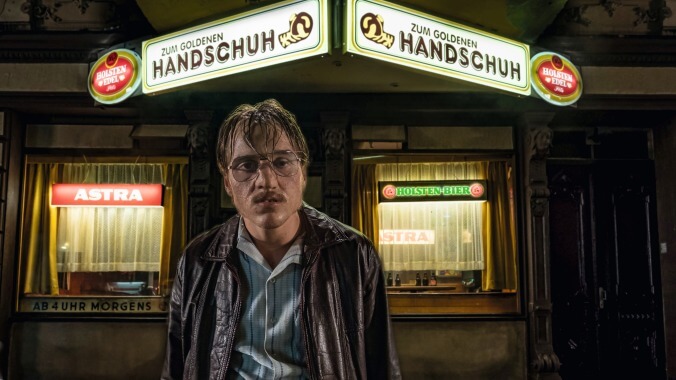Serial-killer drama The Golden Glove is disgusting, nihilistic, and pointless—and that is the point


The Golden Glove stinks. Not in a Jay Sherman sort of way, but in the sense that the film is so viscerally disgusting, with trash strewn on every surface, shit caked on every toilet, and mold growing in every jar of rubbery sausages, that you can practically smell it. The film belongs to a small and alienating subgenre of serial-killer dramas in the tradition of 1986's Henry: Portrait Of A Serial Killer, films that pride themselves on assaulting the viewer with a nonstop gauntlet of brutality and moral emptiness. As such, it doesn’t invite a rewatch, nor can it be recommended to 95 percent of horror fans, even. So what’s the point of its existence? Exactly.
This story is a personal one for director Fatih Akin (Head-On, In The Fade), who grew up in the same working-class Hamburg neighborhood where serial killer Fritz Honka (Jonas Dossler) murdered at least four women between 1971 and 1974. In stereotypical nihilistic German fashion, Akin has said the movie is about both “humanity” and “nothing,” which in practice combines to make a movie about how humans are, in the end, nothing more than meat—rotten, stinking meat infested with maggots, tucked into the crawlspace of a flophouse attic apartment. This point is made quite graphically in the film’s opening scene, which begins with a shot of a woman’s leg clad in a drooping stocking, twisted up in the bloodstained sheets on a sagging bed. A man enters from just out of frame, drags her limp body onto the carpet, strips her of her panties and girdle, and pulls out a saw. You can imagine the rest.
Believe it or not, this is the most tasteful of the movie’s four murder scenes; the sound effects are absolutely sickening, but the actual sawing off of the woman’s head is framed so it’s out of sight, blocked off behind a door. Over the course of the film, the violence moves from the edges of the story to its center, both visually and in terms of Honka’s increasingly unhinged mental state. Four years go by between the opening and the rest of the film—which, save for a brief interlude where Honda gets a job as a night watchman at a sterile office building, is a cycle of heavy drinking, savage sexual assault with a variety of household objects, and rage-fueled murder. (Sexual assault survivors may want to skip this one.) And while that opening scene is undoubtedly shocking, the cumulative effect of all this despair is ultimately even more unsettling.
Honka’s preferred hangout is the dive bar of the title, a place where broken people go in search of sodden oblivion. (This isn’t one of those hipster reproduction “dive bars,” as a college-aged couple discovers towards the end of the film.) At The Golden Glove, dirty old men sit at the bar telling crude jokes, while equally decrepit women bemoan the cruelty of life that reduced them to their current circumstances. The windows are blacked out so no one knows what time it is, and the faces of the patrons are what one might kindly refer to as “interesting.” It’s from this pool of lonely alcoholics that Honka pulls his victims, who are all middle aged or older, overweight, destitute, and desperate enough to follow a stranger into a filthy apartment wallpapered with porno mags for some free booze.
Akin leaves his intention in lingering on the violent degradation of these women open to interpretation. On the one hand, there’s tangible empathy in scenes where each woman reveals her tragic backstory, and defying the titillating trope of watching a monster torture a sexy young girl is a forceful rejoinder to films that glamorize serial killers, like the recent Extremely Wicked, Shockingly Evil And Vile. On that latter point, Honka himself is also portrayed in a humiliating light; star Jonas Dossler wears facial prosthetics that ooze in closeup, and Honka’s tiny penis makes several appearances. He’s an impotent misogynist who’d be pathetic if he wasn’t so irredeemable, and the movie is repulsed by him most of all. But on the other hand, in a film whose unifying aesthetic is unrelenting ugliness, it’s hard to shake the thought that Akin is indulging in a little cruelty of his own by lumping the victims in with all this smelly trash.
Whatever pleasure there is to be found in watching a film like The Golden Glove is in the intellectualizing, and the film does prompt a series of provocative questions about the implicit contract between artist and audience. What’s the purpose of all of this? Does a work of art have to have a moral agenda in order to be valid? In the abstract, the answer is no. Akin clearly knows what he’s doing in terms of filmmaking, and the fact of the matter is that this is a more realistic depiction of what serial murder actually looks like than the vast majority of films on the subject. The real question is: Given that this type of movie has existed for more than 30 years now, how many more variations on its particular theme do we need in order to understand that serial killers are bad? In a world where the idea of Ted Bundy as a sex symbol is regaining traction, maybe one more couldn’t hurt.